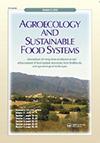Conservation Agriculture in Maize- and Wheat-Based Systems in the (Sub)tropics: Lessons from Adaptation Initiatives in South Asia, Mexico, and Southern Africa
引用次数: 146
Abstract
Conservation agriculture's underlying principles—minimal soil disturbance, soil cover and crop rotation—are increasingly recognized as essential for sustainable agriculture. This article summarizes three contrasting cases of adapting conservation agriculture (CA) to smallholder conditions in the (sub)tropics: a) irrigated rice-wheat systems in South Asia; b) rainfed maize/wheat and irrigated wheat systems in Mexico; and c) rainfed maize in Southern Africa. In the South Asia case, farm surveys show rapid and widespread adoption of zero tillage wheat—primarily due to a substantial cost saving (15–16%). In the other cases, uptake so far has been limited—although long-term trials show continuously higher and more stable yields both for maize and wheat. Under marginal conditions CA can generate substantial yield increases—averaging some 50% over conventional smallholder maize yields of 1 ton per ha over 6 years in on-farm trails in Southern Africa. The diverse experiences attest to the wide adaptability of CA systems, which can generate clear economic and potentially enormous environmental benefits. The case studies and wider literature however also reiterate the substantial challenges in terms of targeting, adapting and adopting CA—particularly for smallholders in the (sub)tropics. CA systems are best developed in situ through a multi-stakeholder adaptive learning process to create viable CA-based options that are technically sound, economically attractive, and socially acceptable.(亚)热带地区玉米和小麦系统的保护性农业:南亚、墨西哥和南部非洲适应计划的经验教训
保护性农业的基本原则——最小的土壤干扰、土壤覆盖和作物轮作——越来越被认为是可持续农业的必要条件。本文总结了在(亚)热带地区使保护性农业(CA)适应小农条件的三个对比案例:a)南亚的水稻-小麦灌溉系统;b)墨西哥的旱作玉米/小麦和灌溉小麦系统;c)非洲南部的雨养玉米。在南亚的案例中,农场调查显示,免耕小麦得到了迅速和广泛的采用,主要是由于节省了大量成本(15-16%)。在其他情况下,尽管长期试验表明玉米和小麦的产量持续提高和稳定,但迄今为止,吸收能力有限。在边际条件下,人工种植可大幅提高产量——在南部非洲的农田试验中,6年期间,平均比传统小农每公顷1吨的玉米产量高出约50%。不同的经验证明了CA系统的广泛适应性,它可以产生明显的经济效益和潜在的巨大环境效益。然而,案例研究和更广泛的文献也重申了在定位、适应和采用ca方面的重大挑战,特别是对(亚)热带的小农。通过多方利益相关者自适应学习过程,以创建技术上合理、经济上有吸引力和社会上可接受的可行的基于CA的选择,在原地开发CA系统是最好的。
本文章由计算机程序翻译,如有差异,请以英文原文为准。
求助全文
约1分钟内获得全文
求助全文

 求助内容:
求助内容: 应助结果提醒方式:
应助结果提醒方式:


